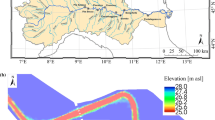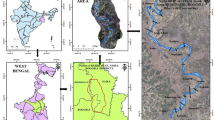Abstract
Coastal areas are more and more exposed to the effects of climatic change. Intense local rainfalls increases the frequency of flash floods and/or flow-like subaerial and afterward submarine landslides. The overall phenomenon of flash flood is complex and involves different phases strongly connected: heavy precipitations in a short period of time, soil erosion, fan deltas forming at mouth and hyperpycnal flows and/or landslides occurrence. Such interrelated phases were separately modelled for simulation purposes by different computational models: Partial Differential Equations methods for weather forecasts and sediment production estimation and Cellular Automata for soil erosion by rainfall and subaerial sediment transport and deposit. Our aim is to complete the model for the last phase of final sediment outcome. This research starts from the results of the previous models and introduces the processes concerning the demolition of fan deltas by sea waves during a sea-storm and the subsequent transport of and sediments in suspension by current at the sea-storm end and their deposition and eventual flowing on the sea bed. A first reduced implementation of the new model SCIDDICA-ss2/w&c1 was applied on the partial reconstruction of the 2016 Bagnara case regarding the meteorological conditions and the flattening of Sfalassà’s fan delta.
Access this chapter
Tax calculation will be finalised at checkout
Purchases are for personal use only
Similar content being viewed by others
References
Pielke Sr., R.A.: Mesoscale Meteorological Modeling, 3rd edn. Academic Press, Boston (2013)
Kalnay, E.: Atmospheric Modeling, Data Assimilation and Predictability. Cambridge University Press, Cambridge (2003)
Richardson, L.F.: Weather Prediction by Numerical Process. Cambridge University Press, Cambridge (1922)
Larosa, S., et al.: A PyQGIS plug-in for the sediments production calculation based on the Erosion Potential Method. In: Gao, W. (eds.) Frontiers of Earth Science (2019, Subm.). ISSN 2095-0195 (print version), ISSN 2095-0209 (el. version)
Avolio, M.V., Di Gregorio, S., Spataro, W., Trunfio, G.A.: A theorem about the algorithm of minimization of differences for multicomponent cellular automata. In: Sirakoulis, G.C., Bandini, S. (eds.) ACRI 2012. LNCS, vol. 7495, pp. 289–298. Springer, Heidelberg (2012). https://doi.org/10.1007/978-3-642-33350-7_30
Di Gregorio, S., Serra, R.: An empirical method for modelling and simulating some complex macroscopic phenomena by cellular automata. Futur. Gener. Comput. Syst. 16, 259–271 (1999)
Calidonna, C.R., Di Gregorio, S., Mango Furnari, M.: Mapping applications of cellular automata into applications of cellular automata networks. Comput. Phys. Commun. 147, 724–728 (2002)
Calidonna, C.R., Naddeo, A., Trunfio, G.A., Di Gregorio, S.: From classical infinite space-time CA to a hybrid CA model for natural sciences modeling. Appl. Math. Comput. 218, 8137–8150 (2012)
Calidonna, C.R., Di Napoli, C., Giordano, M., Mango Furnari, M., Di Gregorio, S.: A network of cellular automata for a landslide simulation. In: ICS 2001, pp. 419–426 (2001)
Mazzanti, P., Bozzano, F., Avolio, M.V., Lupiano, V., Di Gregorio, S.: 3D numerical modelling of submerged and coastal landslides propagation. In: Mosher, D.C., et al. (eds.) Submarine Mass Movements and Their Consequences. NTHR, vol. 28, pp. 127–139. Springer, Dordrecht (2010). https://doi.org/10.1007/978-90-481-3071-9_11
Avolio, M.V., Lupiano, V., Mazzanti, P., Di Gregorio, S.: An advanced cellular model for flow-type landslide with simulations of subaerial and subaqueous cases. In: Proceedings of the EnviroInfo 2009, vol. 501, pp. 131–140 (2009)
Maria, V.A., Francesca, B., Di Gregorio, S., Valeria, L., Paolo, M.: Simulation of submarine landslides by cellular automata methodology. In: Margottini, C., Canuti, P., Sassa, K. (eds.) Landslide Science and Practice, pp. 65–72. Springer, Heidelberg (2013). https://doi.org/10.1007/978-3-642-31427-8_8
Avolio, M.V., Di Gregorio, S., Lupiano, V., Mazzanti, P.: SCIDDICA-SS\(_3\): a new version of cellular automata model for simulating fast moving landslides. J. Supercomput. 65(2), 682–696 (2013). ISSN 0920-8542
Salles, T., Lopez, S., Cacas, M.C., Mulder, T.: Cellular automata model of density currents. Geomorphology 88(1–2), 1–20 (2007)
D’Ambrosio, D., Di Gregorio, S., Gabriele, S., Gaudio, R.: A cellular automata model for soil erosion by water. Phys. Chem. Earth Part B 26(1), 33–39 (2001)
Calidonna, C.R., De Pino, M., Di Gregorio, S., Gullace, F., Gullì, D., Lupiano, D.: A CA model for beach morphodynamics. In: AIP Conference Proceedings. Numerical Computations: Theory and Algorithms (NUMTA 2016), vol. 1776 (2016)
Arai, K., Basuki, A.: Simulation of hot mudflow disaster with cell automaton and verification with satellite imagery data. Int. Arch. Sci. Photogramm. Remote Sens. Spat. Inf. 38 Part 8, 237–242 (2010)
Vanwalleghem, T., Jiménez-Hornero, F., Giráldez, J.V., Laguna, A.M.: Simulation of long-term soil redistribution by tillage using a cellular automata model. Earth Surf. Process. Landf. 35, 761–770 (2010)
Valette, G., Prévost, S., Laurent, L., Léonard, J.: SoDA project: a simulation of soil surface degradation by rainfall. Comput. Graph. 30, 494–506 (2006)
Punzo, M., et al.: Remocean X-band wave radar for wave field analysis: case study of Bagnara Calabra (South Tyrrhenian Sea, Italy). J. Sens. 1, 131–140. Application of X-BandWave Radar for Coastal Dynamic Analysis: Case Test of Bagnara Calabra (South Tyrrhenian Sea, IT) 501, 9 (2016). Article ID: 6236925
Gullace, F.: Un tentativo di Modellizzazione della Morfodinamica degli Arenili con Automi Cellulari. Master theses in Physics, Department Physics, University of Calabria, aa 2015/16 (2016)
Dominici R.: Personal communication (2019)
Avolio, E., Federico, S.: WRF simulations for a heavy rainfall event in southern Italy: verification and sensitivity tests. Atmos. Res. 209, 14–35 (2018)
Auddino, M., Dominici, R., Viscomi, A.: Evaluation of yield sediment in the Sfalassà Fiumara (south western, Calabria) by using Gavrilovi method in GIS enviroment. Rendiconti online della Soc. Geol. Ita. 33, 3–7 (2015)
Author information
Authors and Affiliations
Corresponding author
Editor information
Editors and Affiliations
Rights and permissions
Copyright information
© 2020 Springer Nature Switzerland AG
About this paper
Cite this paper
Lupiano, V. et al. (2020). Final Sediment Outcome from Meteorological Flood Events: A Multi-modelling Approach. In: Sergeyev, Y., Kvasov, D. (eds) Numerical Computations: Theory and Algorithms. NUMTA 2019. Lecture Notes in Computer Science(), vol 11973. Springer, Cham. https://doi.org/10.1007/978-3-030-39081-5_26
Download citation
DOI: https://doi.org/10.1007/978-3-030-39081-5_26
Published:
Publisher Name: Springer, Cham
Print ISBN: 978-3-030-39080-8
Online ISBN: 978-3-030-39081-5
eBook Packages: Computer ScienceComputer Science (R0)




